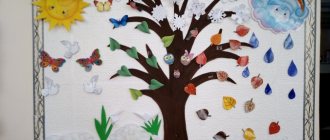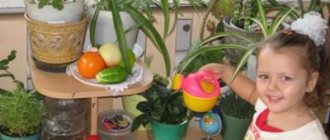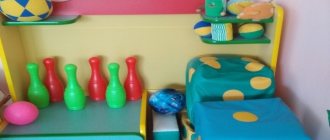Corner of sensorimotor development in preschool educational institutions
All-Russian permanent PROFESSIONAL competition for teachers of preschool educational institutions “Developmental environment in preschool educational institutions”-2021
Savelyeva Irina Valerievna
teacher
MBDOU D/S No. 27 “Beryozka”
Corner of sensorimotor development in preschool educational institutions
The task of teachers in children's institutions is to organize a play area for children, saturate it with such objects, toys, while playing with which the child develops movements, learns to understand their properties - size, shape, and then color, since correctly selected didactic material and toys attract attention baby to the properties of objects. The harmony of the combination of various shapes, sizes, textures, colors of objects, the natural qualities of natural materials not only allow children to master new sensations, but also create a special emotional mood.
Advertising message
Play is the main form and content of organizing children’s lives; play is the most favorite and natural activity of younger preschoolers; the teacher carries out the sensory development of children through play activities. While playing, a child learns touch, perception and assimilates all sensory standards, learns to compare, compare, establish patterns, make independent decisions, develops and learns about the world. Toys are located in different places in the group room so that children do not gather in large groups and disturb each other. Each type of toys and aids is stored in a certain place: large building materials - on shelves, in drawers, balls - in baskets, doll dishes - in a children's closet, books - on a shelf, large toys for movement - in a specially designated corner of the group, etc. d. Such storage of toys ensures order in the group and helps the child to better navigate. Toys and aids are systematically updated, this increases interest in them and allows them to be used more variably.
The group has created a corner for sensorimotor development of children. The corner is intended:
- to stimulate sensory functions (vision, touch, hearing, smell, etc.);
- development of fine motor skills, stimulation of motor activity;
- relieving muscle and psycho-emotional tension, achieving a state of relaxation and comfortable well-being for children;
- creating a positive emotional background, increasing the child’s performance;
- activation of cognitive processes (thinking, attention, perception, memory);
- increasing motivation for independent and experimental activities of preschool children.
The purpose of the sensory corner in the group is the development of all types of perception, the creation of conditions for the implementation of sensory-perceptual abilities, speech and mental development of children, an emotionally positive attitude towards objects and actions with them.
The sensorimotor corner is used in the pedagogical process, both in organized classes and in children’s independent play activities.
A very important part of the development of sensory abilities is “finger games”.
“Finger games” are the staging of some rhymed stories or fairy tales using the fingers. Funny folk nursery rhymes are passed down from generation to generation: “Ladushki-Ladushki”, “Magpie-white-sided”, “Horned Goat” and other finger games. Many games require the participation of both hands, which allows children to navigate the concepts of “right”, “left”, “up”, “down”. Finger games are exercises to improve finger mobility, develop their strength and flexibility. The more a hand can do, the smarter its owner. The movements alternate between compression, stretching, and relaxation; the distribution of tone in the hand and fingers can be traced.
Games with objects have a beneficial effect on the development of movements of the entire hand and fingers: pyramids, inserts of various types, multi-colored abacus, nesting dolls, mosaics, games with pencils, finger pools with various fillers, lacing games, games with clothespins, etc.
Based on the use of sensory games and exercises for the development of tactile and visual perception, preschoolers develop observation, attention, memory, imagination, organize the impressions they received when interacting with the outside world, expand their vocabulary, acquire gaming, educational and experimental skills. search activity.
Corner of sensory development in the second junior group
Kristina Kulikova
Corner of sensory development in the second junior group
The sensory corner is used in the educational process both in organized classes of educators and additional education teachers, and in children’s independent play, search and experimental activities.
Tasks of the sensory corner : Stimulation of sensory functions ; Development of fine motor skills ; Stimulation of motor activity; Relieving muscle and psycho-emotional tension; Creating a positive emotional background; Activation of cognitive processes; Increasing motivation for independent and experimental activities.
Basic principles of organizing the sensorimotor area :
Availability;
Safety;
Creativity;
Variety of objects.
The relevance of a sensory corner in a preschool educational institution
Childhood is a special period of formation of organs and systems and, above all, brain function. It has been proven that the functions of the cerebral cortex are not fixed hereditarily, they develop as a result of the interaction of the body with the environment. This occurs especially intensively in the first three years of life.
A modern child experiences a lack of tactile, auditory, and olfactory sensations. Sometimes he perceives the world around him linearly, one-sidedly. To return the fullness of perception through interaction with real objects is the main purpose of the sensorimotor corner , created today in many preschool institutions.
It is known that the greater the number of sensory systems involved in the process of raising and educating a child, the more successful and efficient his development . Meanwhile, the technologization of modern life creates a deficit in children's sensory experience , replacing it with visual and virtual images.
In the second younger group, the sensorimotor area can be called “Multi-colored mosaic.” Exercises are carried out using corner in order to highlight colors and shades in the environment. Children are invited to find in nature (in the kindergarten area, in a group , at home)
objects whose color matches the proposed color card.
In the sensory corner in the second junior group, for the perception of shape and size and the development of fine motor skills, the following can be used: A set of geometric bodies for seriation by size (Dyenes Blocks)
;Set of planar geometric shapes for seriation by size;
A wonderful bag with a set of geometric shapes, vegetables, fruits. Pyramids painted in primary colors; Stringing rods with colored rings, mosaic; Volume inserts, nesting dolls; Frames - inserts, cubes with slots of different shapes; Set for screwing (box with lids of different colors and shapes)
; Frames-canvases with fasteners (lacing, buttons,
Velcro
); Sets for stringing on fishing line or lace
(beads, balls, toys )
Panel with removable elements
(magnetic board)
.
What is a sensory room for?
It is well known that a person perceives himself and the world around him through receptors, nerve fibers and parts of the brain that react to light, color, sounds, smells and tactile sensations. Therefore, the combination of different stimuli (for example, light, sound or aromatherapy) makes it possible to have a complex effect on the human senses and achieve tremendous success in the development of children of all age categories. At the same time, the use of different sets of stimuli can have both a tonic/stimulating effect and a calming/relaxing effect.
Depending on the age category, the sensory room in kindergarten can be used:
- at an early age (1-3 years) - for the development of general and fine motor skills, the emotional sphere, tactile sensations, observation and attention, as well as the correction of motor disorders, visual coordination, indicative reactions and the enrichment of passive and active vocabulary;
- in preschool age (3-6 years) - for the development of involuntary and logical thinking, higher mental functions (memory, imagination, attention and perception), the emotional sphere, motivation to learn, cognitive interest, as well as learning relaxation skills, increasing resistance to stressful situations and psycho-emotional relief.
Please note that classes in the sensory room can be conducted both in groups and individually. In the case of group classes, the composition of the group is formed based on the needs and physical/psychological/emotional characteristics of each child. Depending on the needs of each group or individual child, classes are conducted in the following areas:
- psychocorrection of the emotional sphere and behavior - aggression and hot temper, isolation and self-doubt, attention deficit disorder and passivity, fears and hyperactivity;
- neuropsychological correction of “school” problems – lack of educational motivation and cognitive interest;
- developmental activities – development of higher mental functions and emotional sphere, achieving psycho-emotional relief, maintaining/restoring psychological health;
- psychotherapy for a wide range of psychoneurological problems.
What is a sensory room?
Sensory room is a room equipped with stimulants that affect the organs of smell, touch, hearing, vision, etc., and aimed at the development of higher mental functions (speech, memory, thinking, attention, imagination, perception, etc.), emotional sphere and personal qualities of the child. In addition, such stimulants contribute to psycho-emotional relief (relaxation), restoration and maintenance of the psychological health of children.
To equip a sensory room, as a rule, the following equipment is used:
- air bubble columns – actively used for visual stimulation, stimulation of tactile sensations and relaxation;
- interactive touch panels - designed for sound and visual stimulation, development of imagination, creativity and fantasy, as well as for developing cause-and-effect relationships and interactive games;
- optical fiber with side glow - used to attract, maintain and stimulate attention;
- tactile panels – promote the development of imagination
, fine motor skills and physical activity, as well as the activation of physical activity and brain activity; - developmental and rehabilitation elements - aimed at developing physical skills, brain activity, general relaxation, toning muscles and achieving psychological balance of the child;
- decorative elements with lighting effects (suspended ceiling, ceiling modules, wall and floor carpets with fiber optics, light projectors, fluorescent paintings or mini-planetariums) - develop research interest, attract attention, promote the development of visual sensations and general relaxation.
In addition, the equipment of a sensory room almost always includes equipment used for sound and aromatherapy: odor generators, air ionizers and humidifiers, music panels, audio players, sets of CDs with musical works, etc.
Unusual lamps (for example, “Flame”, “Plasma”, “Vulcan” lamps or salt lamps), as well as non-standard upholstered furniture (for example, a ball ottoman, a water mattress or a cube chair) give the sensory rooms a special coziness and atmosphere of comfort. various soft play modules: transformable houses, dry pools with balls, educational tables, play screens, tactile paths, floor constructors and much more. In addition to its main purpose - conducting play activities, developing tactile sensations and physical abilities of children - the soft filling of sensory rooms has massage and relaxing effects, and also guarantees the safety of developmental activities.





